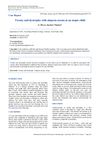Study on Serum Vitamin D in Alopecia Areata Patients
April 2019
in “
Journal of Nepal Health Research Council
”
TLDR People with Alopecia areata often have lower vitamin D levels, which may be linked to the severity of their condition.
The study conducted by Marahatta, Agrawal, and Khan in 2019 involved 30 newly diagnosed Alopecia areata patients and aimed to compare their serum vitamin D levels with healthy controls, as well as assess the relationship between serum vitamin D levels and Alopecia areata disease severity. The results showed that the prevalence of vitamin D deficiency was significantly higher in the Alopecia areata group (83.3%) compared to the control group (53.3%). Additionally, the serum vitamin D level was lower in the Alopecia areata group than in the control group. The study also found an inverse correlation between serum vitamin D level and the Severity of Alopecia Tool (SALT) score, indicating that lower vitamin D levels were associated with more severe Alopecia areata.

